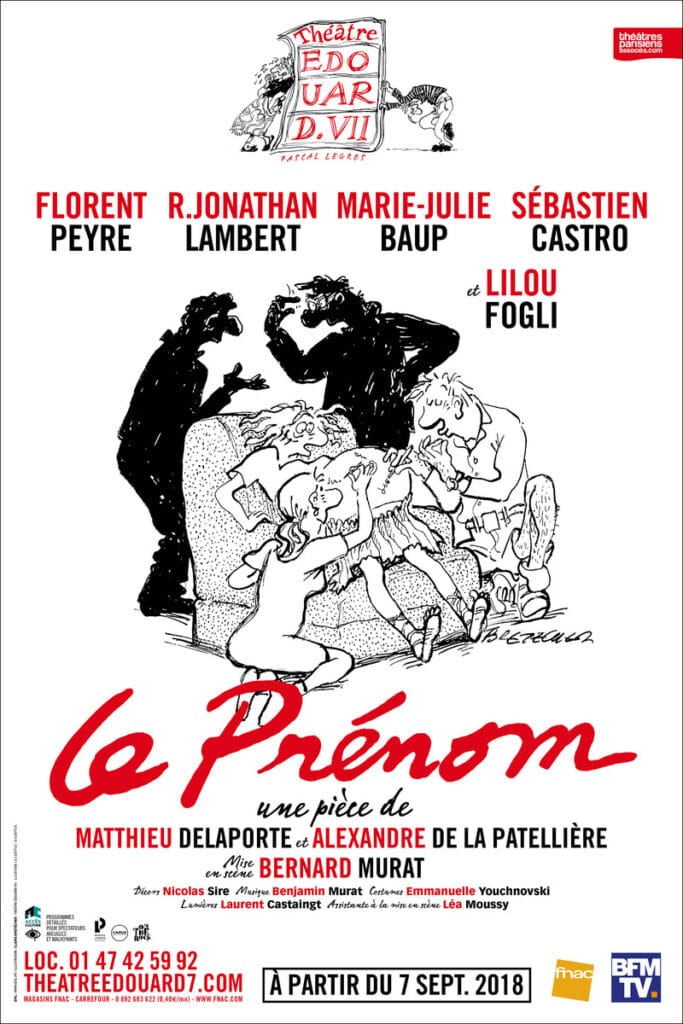“Le Prénom,” a French theatrical gem written by Matthieu Delaporte and Alexandre de La Patellière, has captivated audiences with its sharp wit, intricate character dynamics, and thought-provoking themes since its debut. This play offers a delightful yet piercing examination of relationships, family dynamics, and the power of words. Its success on stage is a testament to its clever dialogue, compelling performances, and a universal theme that resonates deeply with audiences.

The Story and Its Unfolding
“Le Prénom” centers around a seemingly innocuous dinner party that quickly devolves into a night of intense confrontation and revelation. The plot, while deceptively simple, is executed with masterful precision. Vincent, a middle-aged real estate agent, is invited to his sister Elisabeth’s and her husband Pierre’s apartment for dinner. Also present are Claude, a childhood friend, and Anna, Vincent’s pregnant wife. The evening takes an unexpected turn when Vincent reveals the name he and Anna have chosen for their unborn son: Adolphe. This announcement acts as a catalyst, sparking heated debates and unearthing long-buried secrets and tensions among the group.

Character Dynamics
One of the unique aspects of “Le Prénom” is its character-driven narrative. Each character is meticulously crafted, with distinct personalities and backstories that enrich the unfolding drama.
- Vincent: The provocateur of the evening, Vincent is charismatic, confident, and somewhat arrogant. His choice of the name Adolphe is deliberately provocative, setting off a chain reaction of arguments and revelations. Vincent’s character is complex; he oscillates between being a charming jokester and a figure of deep emotional insight.
- Pierre: An intellectual and professor of literature, Pierre is initially the voice of reason, or so it seems. He is analytical, idealistic, and somewhat pedantic, often clashing with Vincent’s more laid-back and provocative demeanor. Pierre’s character represents the conflict between intellectual ideals and emotional realities.
- Elisabeth: Often caught in the crossfire, Elisabeth is the emotional anchor of the group. She is caring and nurturing, yet harbors her own frustrations and secrets. Her role in the family dynamics is crucial, as she balances the often volatile interactions between the other characters.
- Claude: A mild-mannered musician and childhood friend of Elisabeth and Vincent, Claude initially appears as the neutral party. However, his character’s deeper layers are revealed as the evening progresses, showing his struggles with identity and acceptance.
- Anna: Vincent’s pregnant wife, Anna, is somewhat of an outsider to the group. Her observations and reactions offer a fresh perspective on the family dynamics. Anna’s character is pivotal in highlighting the theme of new beginnings versus old conflicts.
Themes and Dialogue
The play delves into themes of identity, societal expectations, and the influence of history on personal choices. The name “Adolphe,” reminiscent of Adolf Hitler, serves as a provocative symbol that challenges the characters’ beliefs and prejudices. The dialogue is sharp, witty, and laced with humor, making the heavy themes more accessible and engaging. Delaporte and de La Patellière skillfully use humor to diffuse tension while simultaneously deepening the emotional impact of the revelations.
The discussions about the name “Adolphe” evolve into broader debates on topics such as history, memory, and the lasting impact of past atrocities. These discussions are interspersed with personal jabs, comedic misunderstandings, and poignant moments of truth, creating a rich tapestry of interaction that keeps the audience engaged from start to finish.



The Stage Setting
The setting of “Le Prénom” is integral to its charm and effectiveness. The entire play takes place in Elisabeth and Pierre’s apartment, a choice that creates an intimate atmosphere. This confined space enhances the feeling of entrapment and intensity as the characters’ emotions escalate. The set design is typically that of a middle-class Parisian apartment, with a cozy yet sophisticated décor that reflects the hosts’ personalities. Bookshelves, comfortable seating, and a dining table set the scene for what initially appears to be a mundane evening.
The Use of Space
The use of space in “Le Prénom” is masterful. The apartment setting allows for a natural flow of movement and interaction among the characters. The dining table becomes a focal point for the heated discussions, while the living room area provides a space for more personal and revealing conversations. The limited setting forces the characters to confront each other directly, heightening the emotional stakes and the play’s dramatic impact.
The physical proximity of the characters within the confined space of the apartment amplifies the tension and intimacy of their interactions. The actors use the space dynamically, moving between the dining table, the living room, and other parts of the apartment to reflect the shifts in the emotional landscape. This careful choreography ensures that the audience remains visually and emotionally engaged.

Lighting and Sound
Lighting and sound play crucial roles in enhancing the play’s atmosphere. Subtle changes in lighting reflect the shifts in mood and tension, while sound effects, such as the ringing of a phone or the clinking of glasses, add realism to the scene. The designers use these elements sparingly but effectively, ensuring that they support rather than overshadow the performances.
For instance, warm, ambient lighting creates an inviting and relaxed atmosphere at the beginning of the play, reflecting the initial casual and friendly tone of the gathering. As the conversation heats up and tensions rise, the lighting subtly shifts to cooler, harsher tones, mirroring the emotional intensity and discomfort of the characters. These changes in lighting are often complemented by the use of shadows to underscore moments of conflict or revelation.
Sound design is similarly nuanced. Background noises, such as the distant hum of city life or the subtle ticking of a clock, create a sense of realism and continuity. These sounds often fade away during key moments of dialogue, drawing the audience’s focus entirely to the characters’ words and actions. The strategic use of silence is also powerful, highlighting the weight of certain revelations or the awkwardness of uncomfortable pauses.

The Movie Adaptation
In 2012, “Le Prénom” was adapted into a film, directed by Matthieu Delaporte and Alexandre de La Patellière, the original playwrights. The movie retained the essence of the play while expanding its visual scope. The film adaptation was a massive hit in France, earning critical acclaim and numerous awards.
Staying True to the Play
The film adaptation of “Le Prénom” remained remarkably faithful to the original play. The dialogue, much of which is taken verbatim from the stage script, retains its sharpness and humor. The filmmakers expanded the setting slightly, using different rooms of the apartment to add visual variety and depth to the scenes. This expansion allowed for more dynamic cinematography while maintaining the play’s intimate feel.
Performance and Casting
The cast of the film included many of the original stage actors, which added a layer of authenticity to the performances. Patrick Bruel (Vincent), Valérie Benguigui (Elisabeth), Charles Berling (Pierre), and Guillaume de Tonquédec (Claude) reprised their roles, bringing a deep understanding of their characters to the screen. Judith El Zein joined the cast as Anna, delivering a performance that perfectly complemented the established dynamics.
The familiarity of the actors with their roles allowed for nuanced and deeply connected performances. Their chemistry is palpable, and their comfort with the material enables them to explore the characters’ complexities fully. The performances in the film are a testament to the actors’ skill and their deep understanding of the characters’ emotional landscapes.

Cinematic Techniques
The film employed cinematic techniques to enhance the storytelling. Flashbacks and cutaways provided context and backstory, enriching the narrative without disrupting the flow of dialogue. The filmmakers used close-ups to capture the characters’ emotions, adding a layer of intimacy that is sometimes challenging to achieve on stage. The use of music and sound design further enhanced the mood, emphasizing the comedic and dramatic beats.
For example, flashbacks are used to provide insight into the characters’ past interactions and relationships, adding depth to their present conflicts. These flashbacks are seamlessly integrated into the narrative, using visual cues and transitions that maintain the flow of the story. Close-ups and medium shots focus on the characters’ facial expressions and body language, capturing subtle emotional shifts that might be missed in a stage production.
Music also plays a significant role in the film, with a carefully curated soundtrack that underscores key moments and enhances the emotional impact. The use of both diegetic and non-diegetic music helps to create a cohesive and immersive cinematic experience.




Critical Reception
The movie adaptation of “Le Prénom” received widespread acclaim. Critics praised its faithful adaptation, sharp dialogue, and outstanding performances. The film was nominated for several César Awards (the French equivalent of the Oscars), with Valérie Benguigui and Guillaume de Tonquédec winning for Best Supporting Actress and Best Supporting Actor, respectively. The success of the film highlighted the universal appeal of the story and its themes, reaching a broader audience beyond the theatre-goers.
The film’s critical reception was bolstered by its ability to maintain the play’s sharp wit and emotional depth while leveraging the advantages of the cinematic medium. Reviewers highlighted the seamless transition from stage to screen, noting how the film retained the intimacy and intensity of the original play while expanding its visual and emotional scope.
Thematic Exploration and Cultural Impact
“Le Prénom” explores several profound themes through its engaging narrative and dynamic characters. The play and its film adaptation offer a nuanced examination of identity, societal expectations, and the lasting impact of historical events on personal lives.
Identity and Naming
The central conflict revolves around the name “Adolphe,” a choice that brings up painful historical associations with Adolf Hitler. This choice serves as a catalyst for discussions about identity, heritage, and the power of names. The characters’ reactions to the name reveal their underlying biases, fears, and unresolved issues.
Vincent’s provocative choice forces the characters to confront their prejudices and the weight of history. The name becomes a symbol of the struggle between personal freedom and societal norms, highlighting how individual choices can be influenced by collective memory and cultural taboos.

Family Dynamics
The play also delves deeply into the complexities of family relationships. The interactions between Vincent, Elisabeth, Pierre, and Claude reveal the intricate web of love, rivalry, resentment, and loyalty that binds them. The dinner party setting serves as a microcosm of family life, where old wounds are reopened, and long-held grudges come to the surface.
Elisabeth and Pierre’s marriage is scrutinized, revealing underlying tensions and unspoken frustrations. Vincent’s relationship with his sister and brother-in-law is similarly fraught, characterized by a mix of affection and antagonism. Claude’s presence adds another layer of complexity, as his longstanding friendship with the family makes him both an insider and an outsider.
The Power of Words
At its core, “Le Prénom” is a play about the power of words. The choice of a name sets off a chain reaction of debates, confessions, and confrontations. The dialogue is sharp and incisive, revealing the characters’ true feelings and motivations. Words become weapons, tools of persuasion, and means of self-expression.
The play highlights how language can shape reality, influence perceptions, and trigger emotional responses. The characters’ verbal sparring is both entertaining and illuminating, showcasing the nuances of communication and the impact of speech on relationships.




Societal Expectations
“Le Prénom” also addresses societal expectations and the pressure to conform. The characters grapple with their roles within the family and society at large, struggling to balance personal desires with external pressures. Vincent’s provocative nature challenges these expectations, forcing the others to question their own beliefs and values.
The play’s exploration of societal norms is both timely and timeless, resonating with audiences who face similar struggles in their own lives. The characters’ conflicts and resolutions offer a mirror to the audience, reflecting their own experiences and prompting introspection.
Conclusion
“Le Prénom” is a remarkable play that stands out for its clever writing, rich character development, and the skillful use of a single setting to create a compelling narrative. Its exploration of identity, societal norms, and the impact of words resonates deeply with audiences, making it both entertaining and thought-provoking. The success of its film adaptation further underscores the play’s strength and universal appeal.
Whether experienced on stage or on screen, “Le Prénom” offers a captivating glimpse into the complexities of human relationships and the power of communication. Its blend of humor and drama, coupled with exceptional performances, ensures that it remains a beloved piece of contemporary theatre and cinema. The play and its adaptation continue to inspire and provoke thought, highlighting the enduring relevance of its themes and the brilliance of its execution.
With its sharp wit, emotional depth, and timeless themes, “Le Prénom” has secured its place as a unique and fascinating work of art, cherished by audiences and critics alike. Its legacy endures, inviting new generations to explore its rich narrative and reflect on the profound questions it raises about identity, family, and the power of words.






